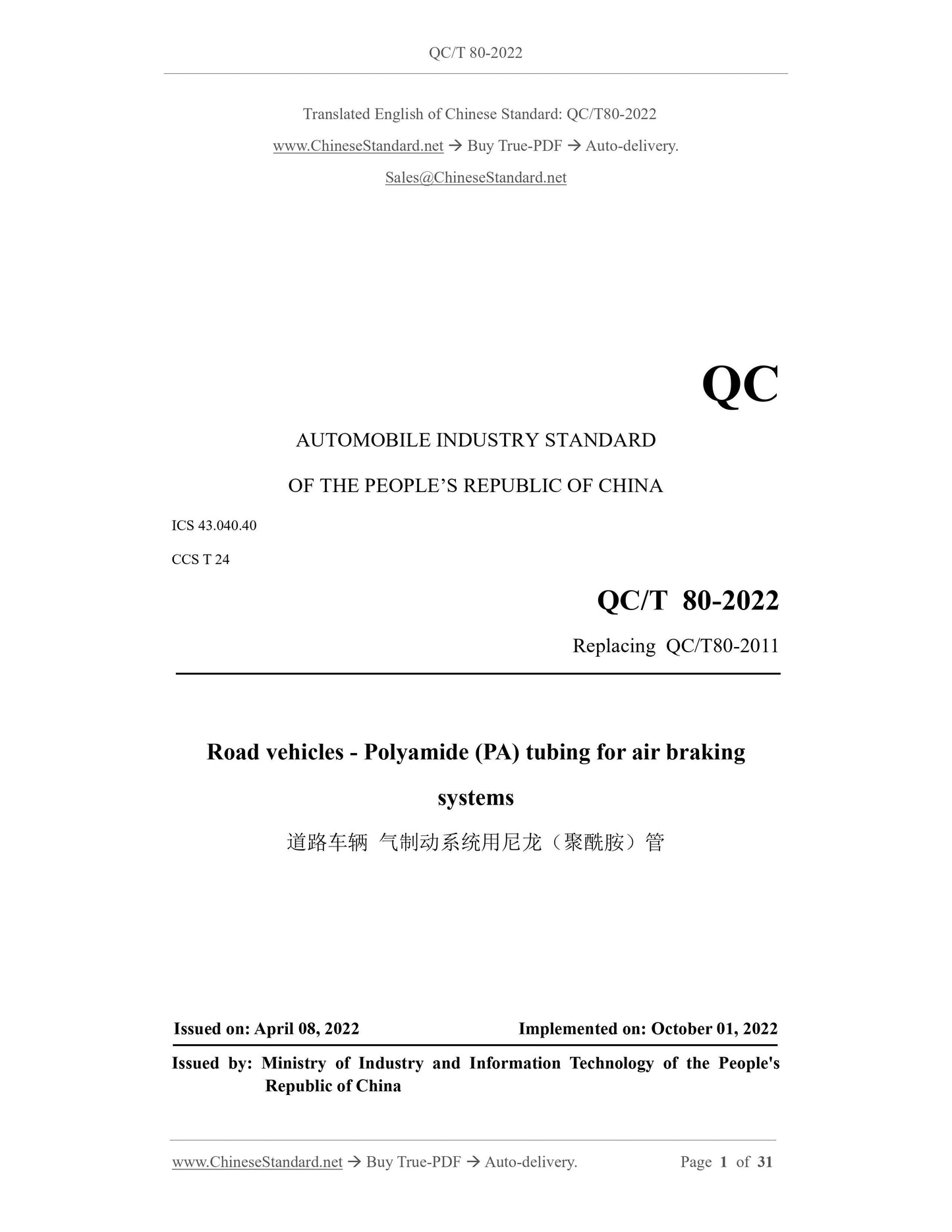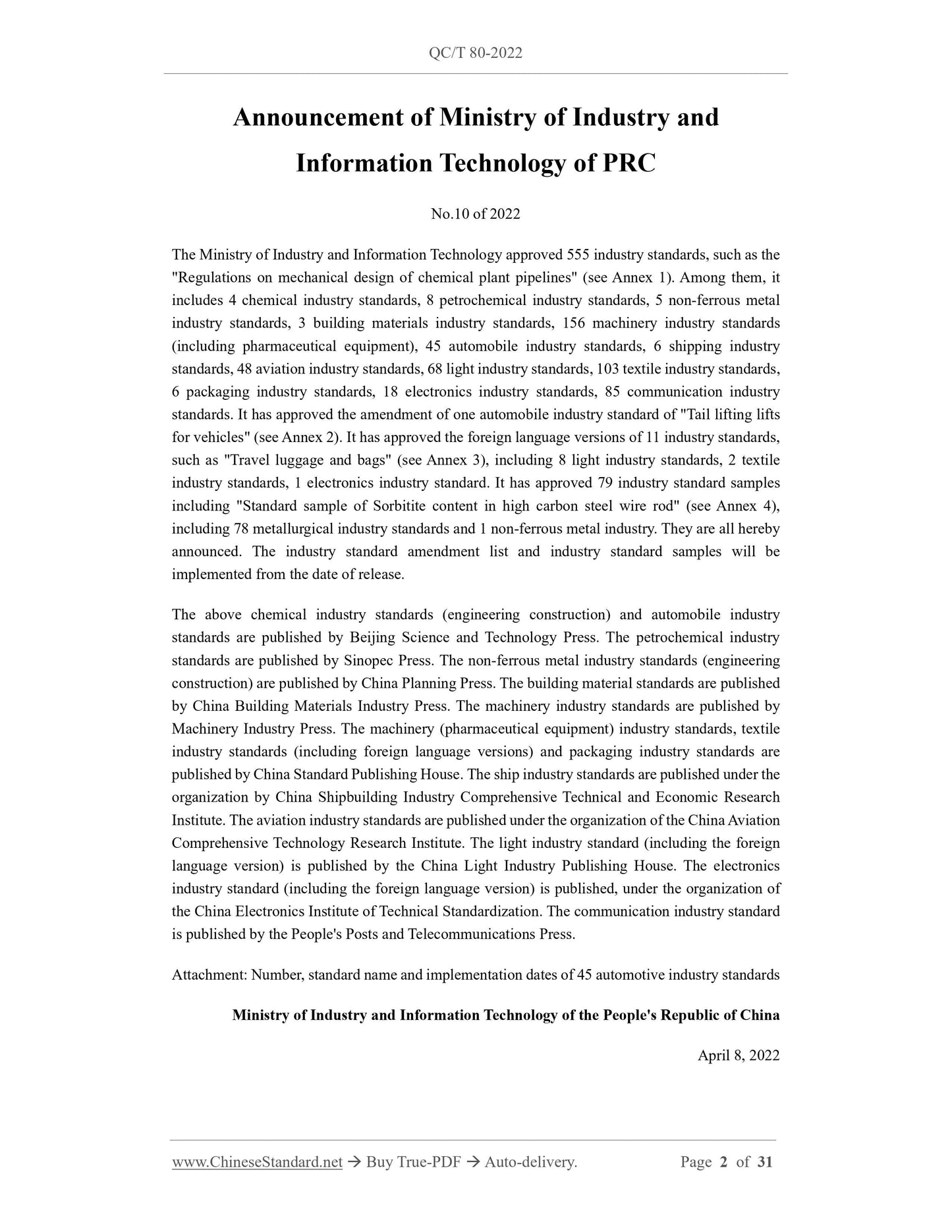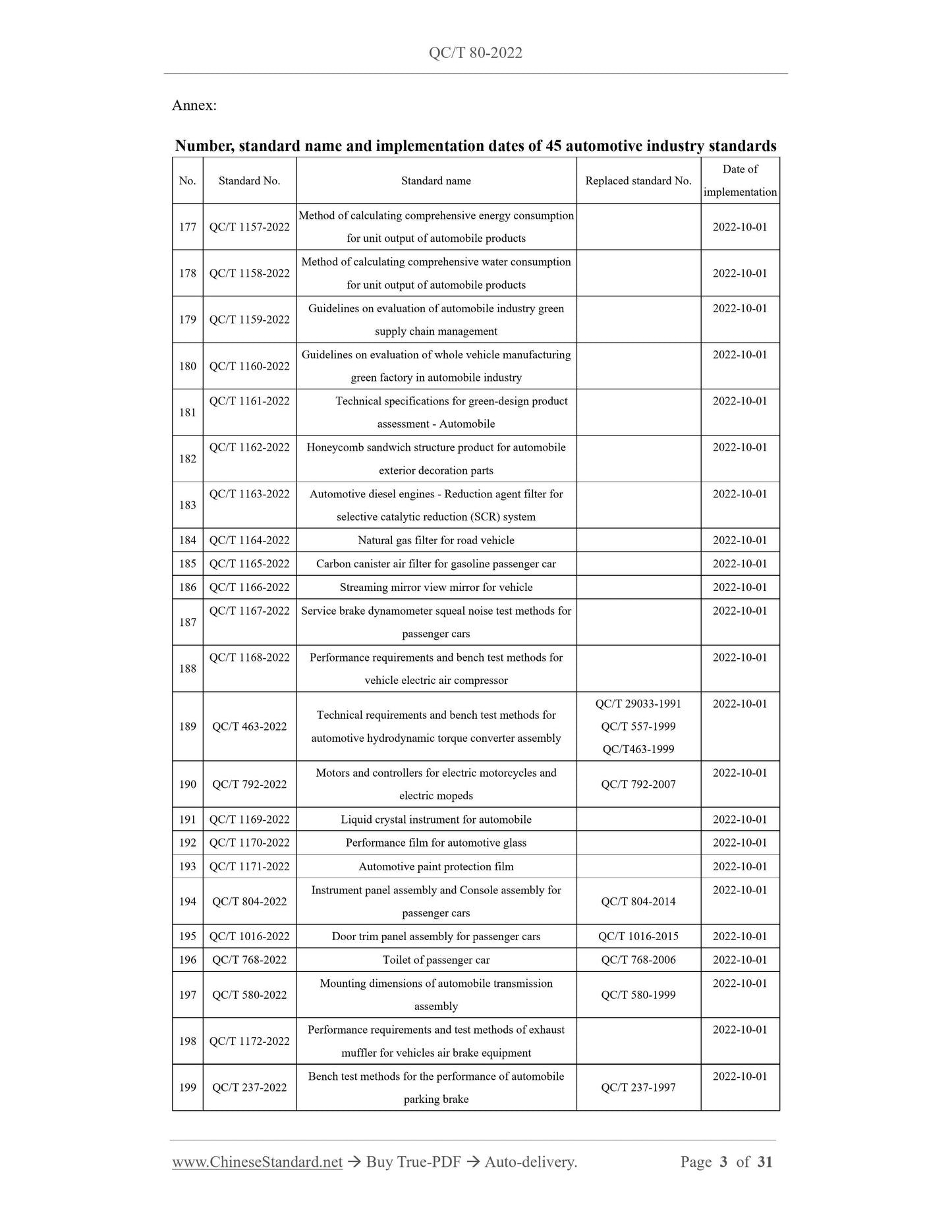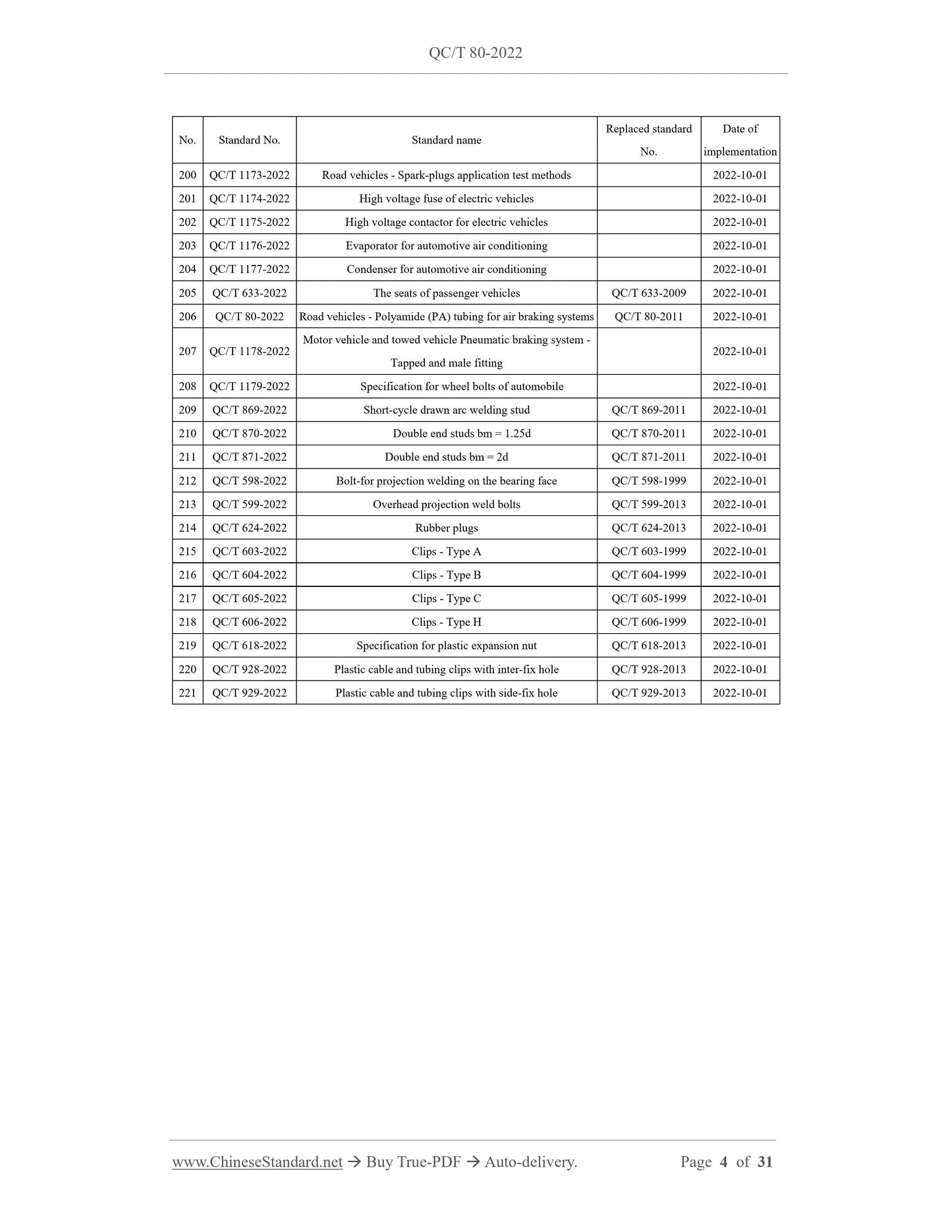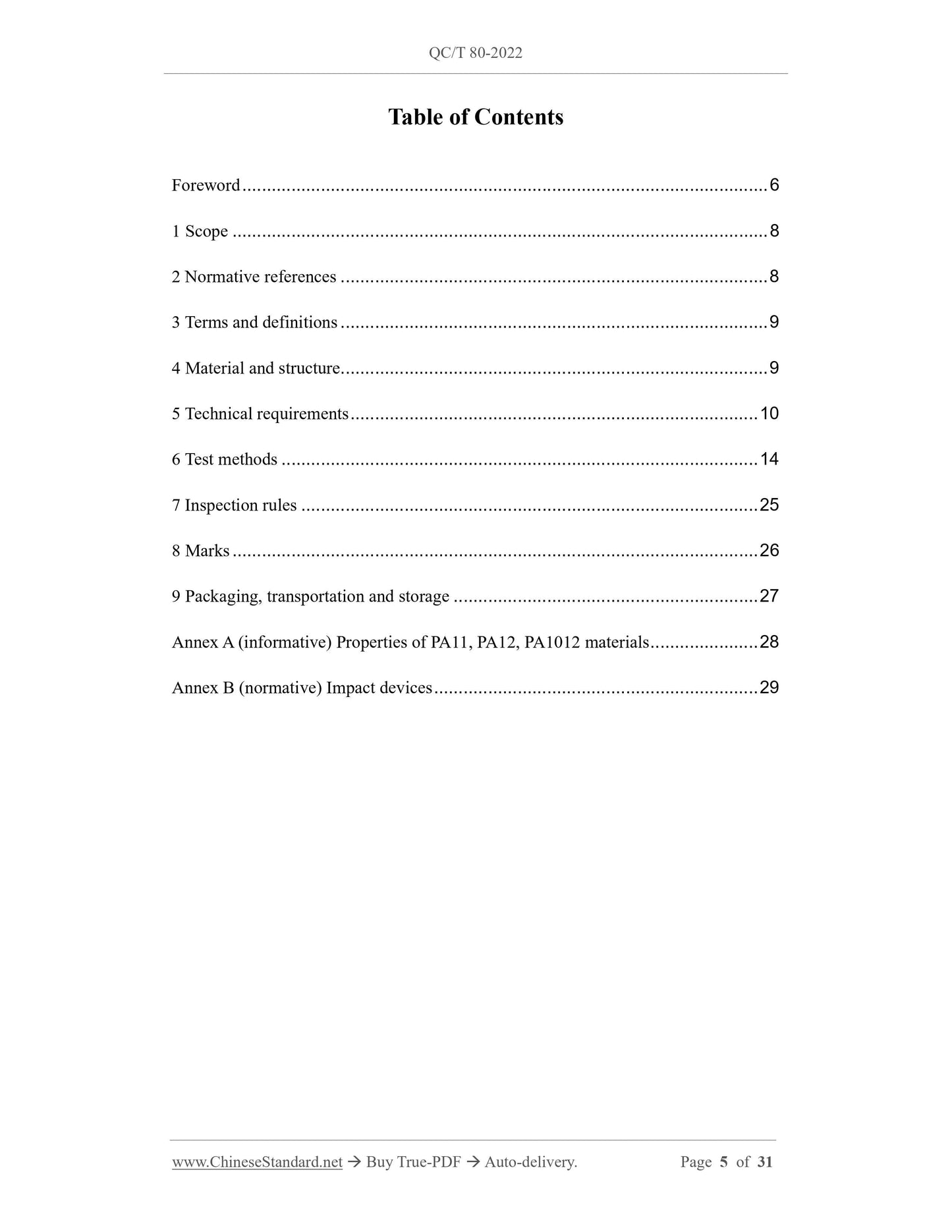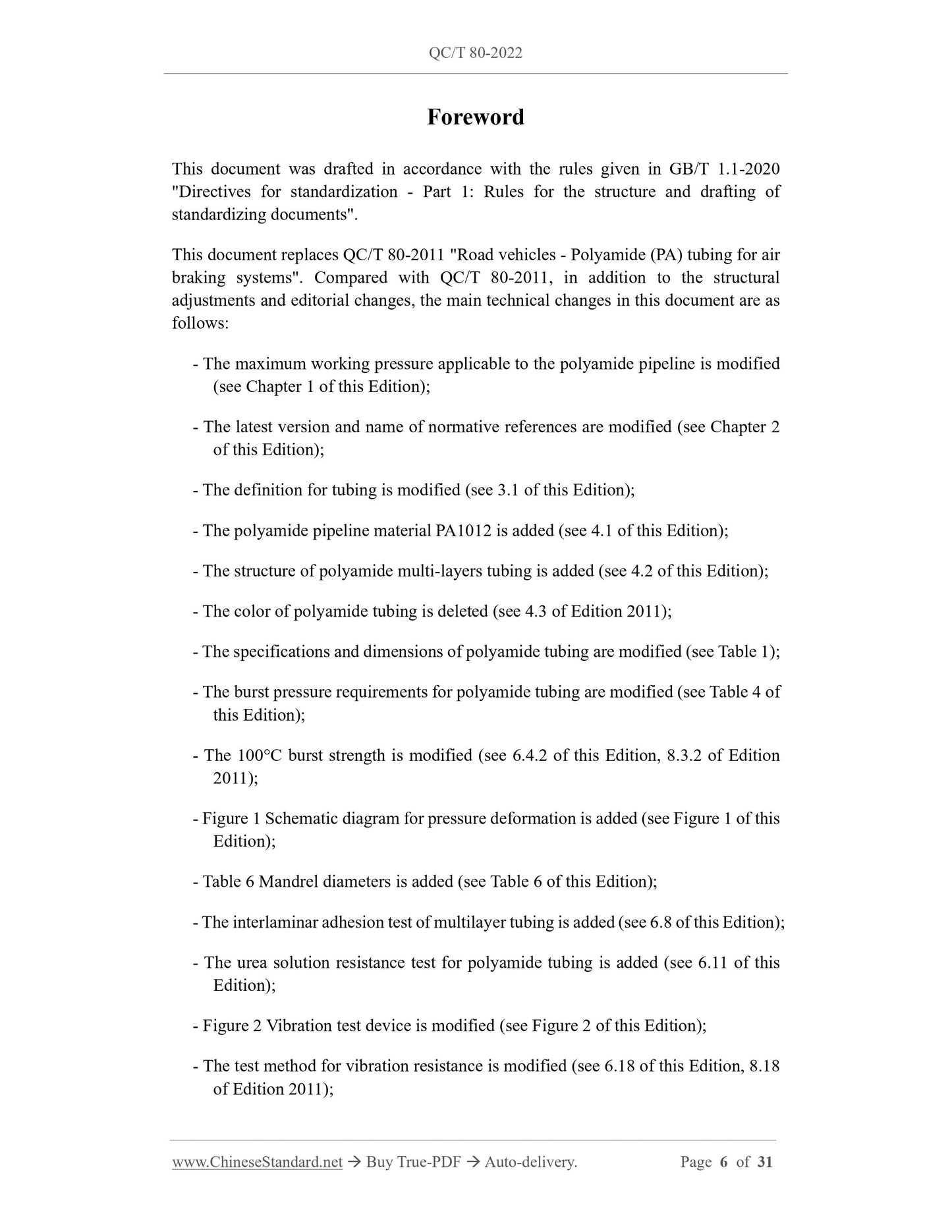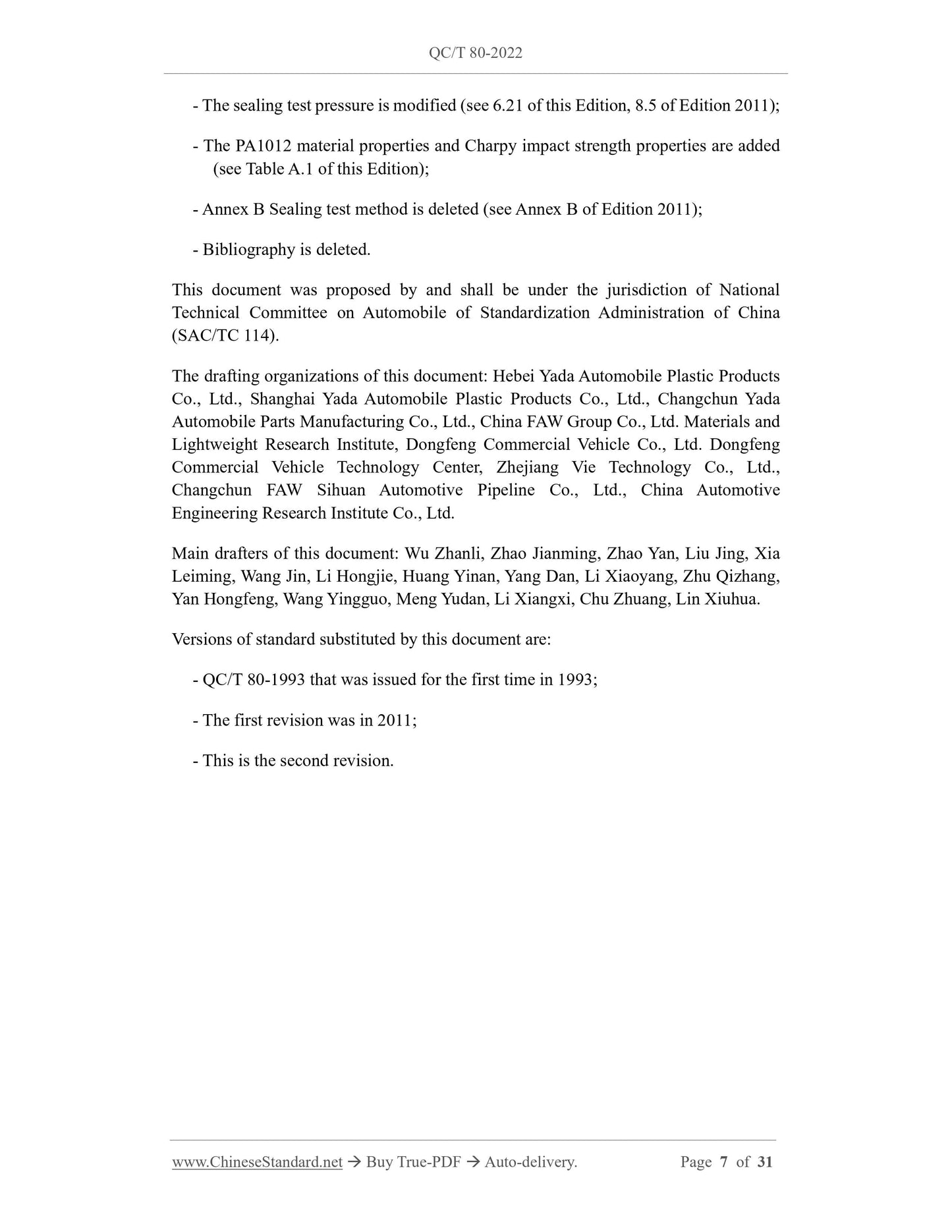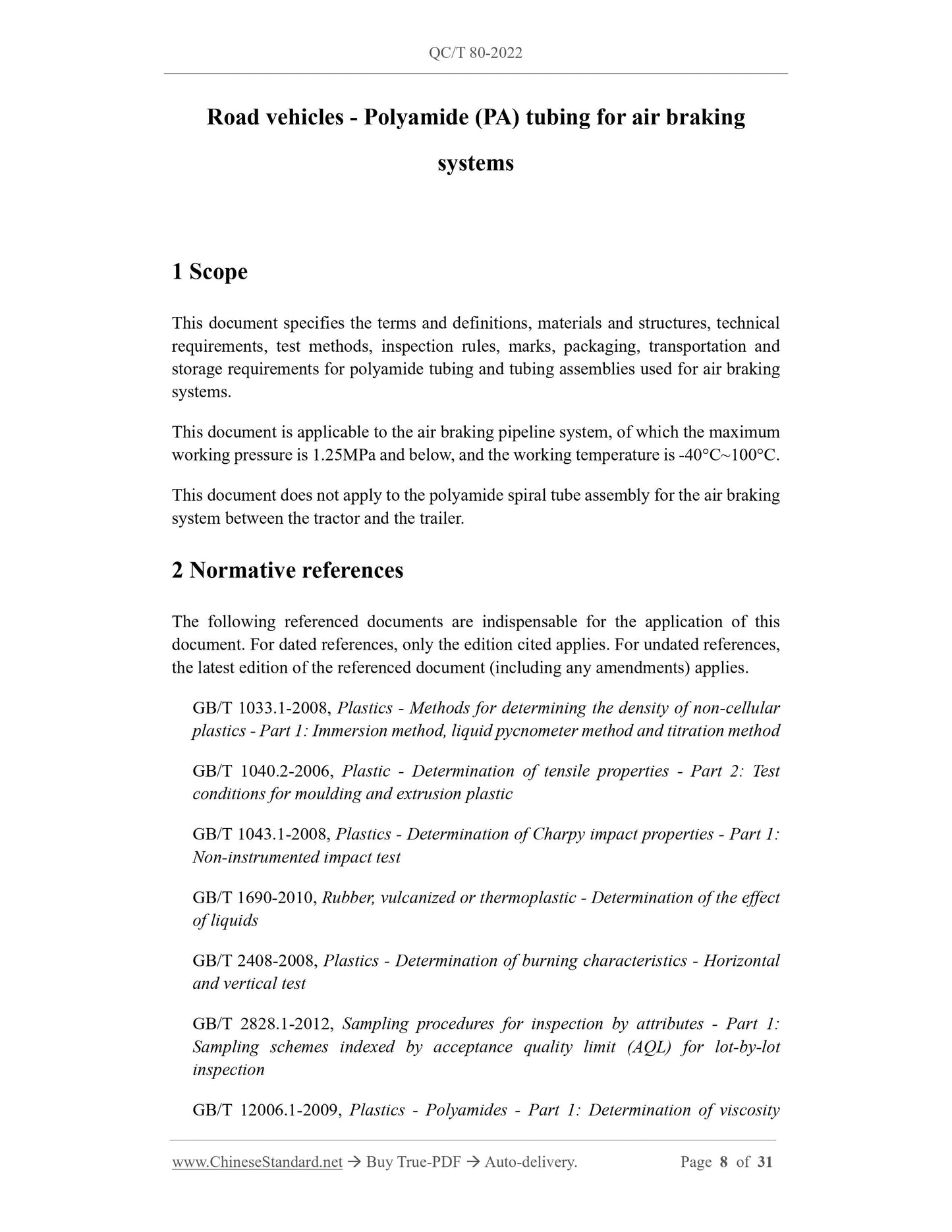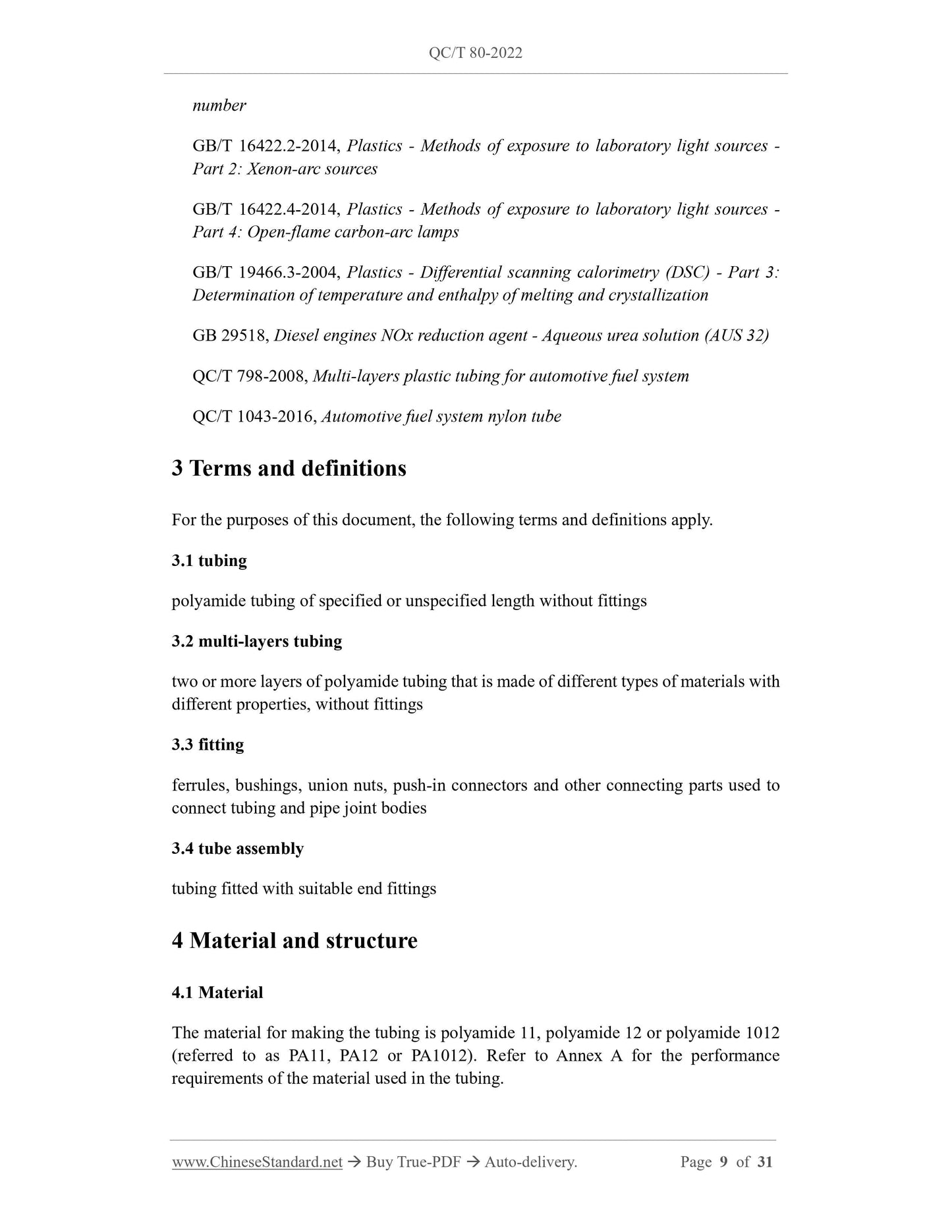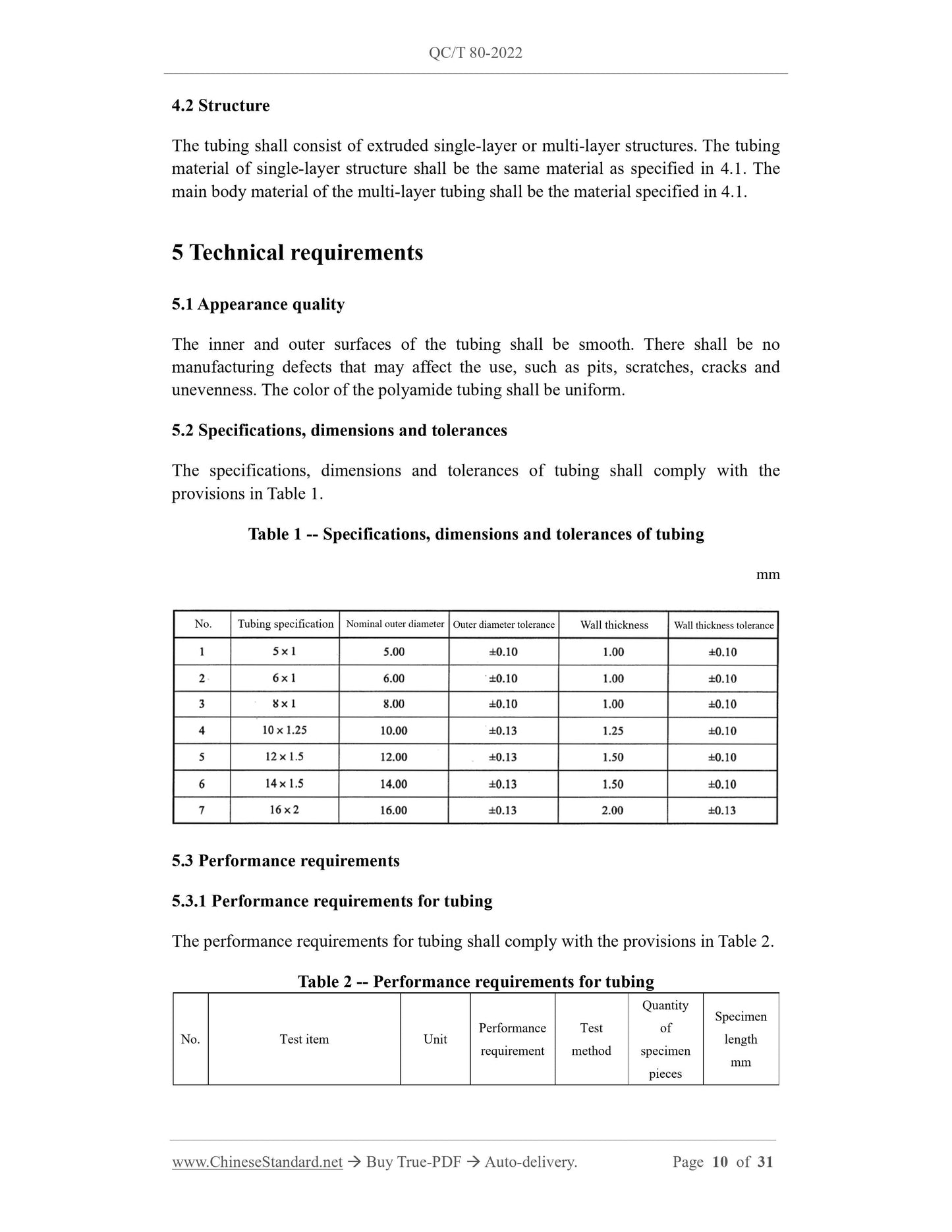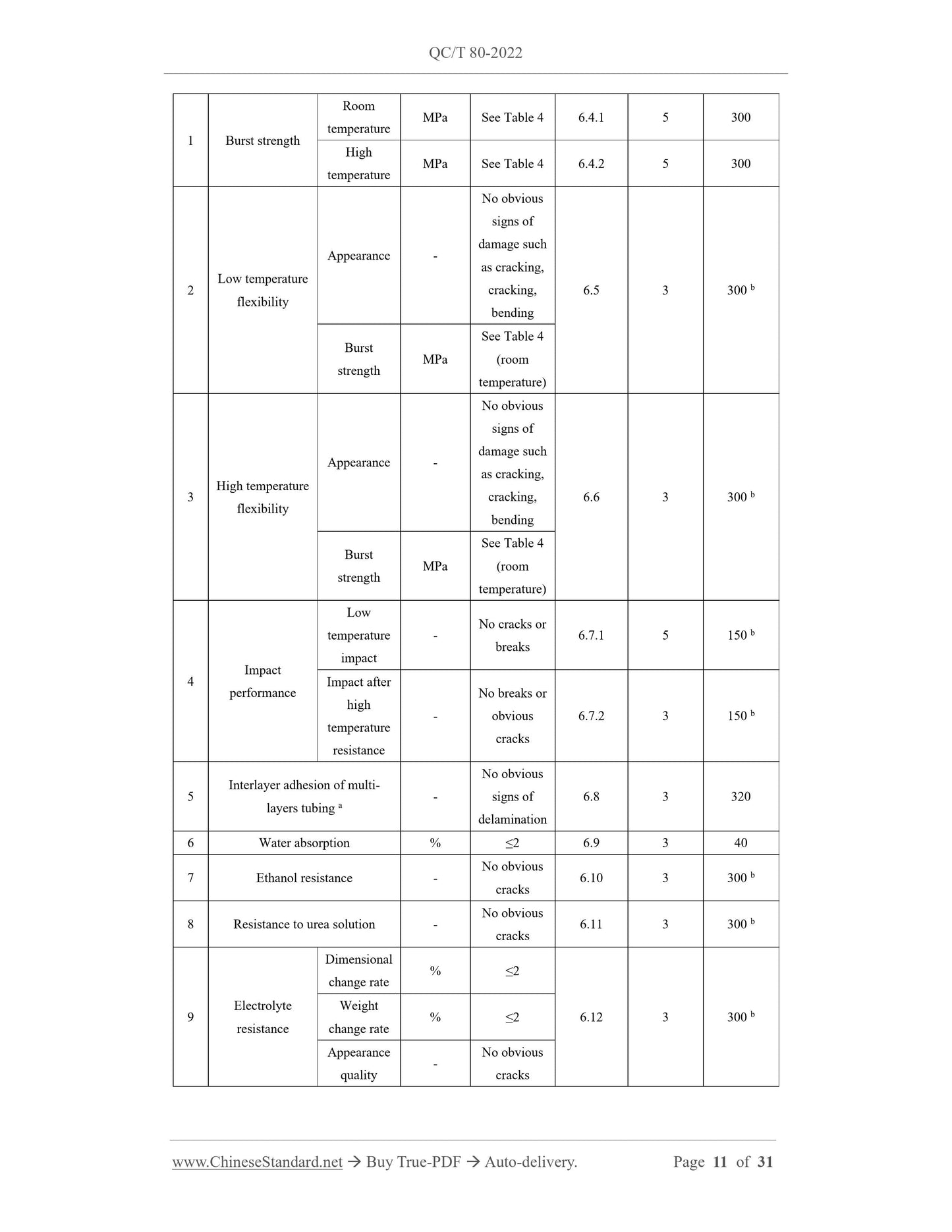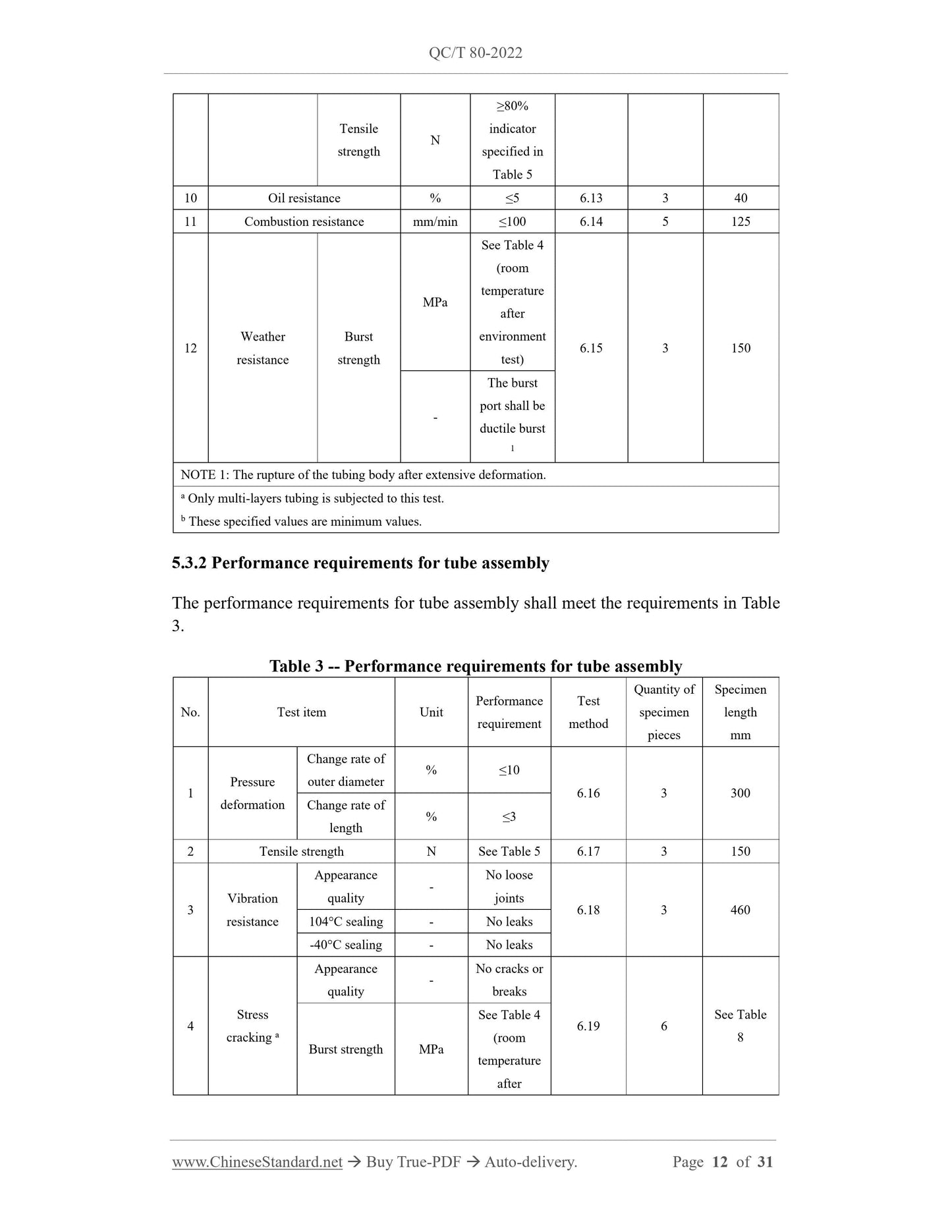1
/
of
12
PayPal, credit cards. Download editable-PDF & invoice in 1 second!
QC/T 80-2022 English PDF (QC/T80-2022)
QC/T 80-2022 English PDF (QC/T80-2022)
Regular price
$320.00 USD
Regular price
Sale price
$320.00 USD
Unit price
/
per
Shipping calculated at checkout.
Couldn't load pickup availability
Delivery: 3 seconds. Download true-PDF + Invoice.
Get QUOTATION in 1-minute: Click QC/T 80-2022
Historical versions: QC/T 80-2022
Preview True-PDF (Reload/Scroll if blank)
QC/T 80-2022: Road vehicles - Polyamide(PA) tubing for air braking systems
QC/T 80-2022
QC
AUTOMOBILE INDUSTRY STANDARD
OF THE PEOPLE’S REPUBLIC OF CHINA
ICS 43.040.40
CCS T 24
Replacing QC/T80-2011
Road vehicles - Polyamide (PA) tubing for air braking
systems
ISSUED ON: APRIL 08, 2022
IMPLEMENTED ON: OCTOBER 01, 2022
Issued by: Ministry of Industry and Information Technology of the People's
Republic of China
Table of Contents
Foreword ... 8
1 Scope ... 10
2 Normative references ... 10
3 Terms and definitions ... 11
4 Material and structure ... 11
5 Technical requirements ... 12
6 Test methods ... 16
7 Inspection rules ... 27
8 Marks ... 28
9 Packaging, transportation and storage ... 29
Annex A (informative) Properties of PA11, PA12, PA1012 materials ... 30
Annex B (normative) Impact devices ... 31
Road vehicles - Polyamide (PA) tubing for air braking
systems
1 Scope
This document specifies the terms and definitions, materials and structures, technical
requirements, test methods, inspection rules, marks, packaging, transportation and
storage requirements for polyamide tubing and tubing assemblies used for air braking
systems.
This document is applicable to the air braking pipeline system, of which the maximum
working pressure is 1.25MPa and below, and the working temperature is -40°C~100°C.
This document does not apply to the polyamide spiral tube assembly for the air braking
system between the tractor and the trailer.
2 Normative references
The following referenced documents are indispensable for the application of this
document. For dated references, only the edition cited applies. For undated references,
the latest edition of the referenced document (including any amendments) applies.
GB/T 1033.1-2008, Plastics - Methods for determining the density of non-cellular
plastics - Part 1: Immersion method, liquid pycnometer method and titration method
GB/T 1040.2-2006, Plastic - Determination of tensile properties - Part 2: Test
conditions for moulding and extrusion plastic
GB/T 1043.1-2008, Plastics - Determination of Charpy impact properties - Part 1:
Non-instrumented impact test
GB/T 1690-2010, Rubber, vulcanized or thermoplastic - Determination of the effect
of liquids
GB/T 2408-2008, Plastics - Determination of burning characteristics - Horizontal
and vertical test
GB/T 2828.1-2012, Sampling procedures for inspection by attributes - Part 1:
Sampling schemes indexed by acceptance quality limit (AQL) for lot-by-lot
inspection
GB/T 12006.1-2009, Plastics - Polyamides - Part 1: Determination of viscosity
number
GB/T 16422.2-2014, Plastics - Methods of exposure to laboratory light sources -
Part 2: Xenon-arc sources
GB/T 16422.4-2014, Plastics - Methods of exposure to laboratory light sources -
Part 4: Open-flame carbon-arc lamps
GB/T 19466.3-2004, Plastics - Differential scanning calorimetry (DSC) - Part 3:
Determination of temperature and enthalpy of melting and crystallization
GB 29518, Diesel engines NOx reduction agent - Aqueous urea solution (AUS 32)
QC/T 798-2008, Multi-layers plastic tubing for automotive fuel system
QC/T 1043-2016, Automotive fuel system nylon tube
3 Terms and definitions
For the purposes of this document, the following terms and definitions apply.
3.1 tubing
polyamide tubing of specified or unspecified length without fittings
3.2 multi-layers tubing
two or more layers of polyamide tubing that is made of different types of materials with
different properties, without fittings
3.3 fitting
ferrules, bushings, union nuts, push-in connectors and other connecting parts used to
connect tubing and pipe joint bodies
3.4 tube assembly
tubing fitted with suitable end fittings
4 Material and structure
4.1 Material
The material for making the tubing is polyamide 11, polyamide 12 or polyamide 1012
(referred to as PA11, PA12 or PA1012). Refer to Annex A for the performance
requirements of the material used in the tubing.
(cut the desired length from the rewind area; the necessary length for the burst strength
test shall include the portion of the tubing at high temperature).
6.7 Impact performance
6.7.1 Low temperature impact
6.7.1.1 Test devices
See Annex B for the impact test devices.
6.7.1.2 Test steps
Place the straight tubing specimen in a low temperature box at -40°C±2°C for 2h. Take
out the specimen. Under the ambient temperature of 23°C±2°C, the impact test shall be
carried out in accordance with the provisions of GB/T 1043.1-2008 within 5s.
6.7.2 Impact after resistance to high temperature
6.7.2.1 Test devices
See Annex B for the impact test devices.
6.7.2.2 Test steps
Place the specimen in a high-temperature box at 150°C±2°C for 72h. Then cool to
23°C±2°C. After stabilizing at this temperature for 4h, carry out the impact test
according to the provisions of GB/T 1043.1-2008.
6.8 Interlayer adhesion of multi-layers tubing
Carry out the test in accordance with the provisions in 7.11.1 of QC/T 798-2008.
6.9 Water absorption
Place the specimen in a high temperature box at 100°C±2°C for 24h. Take it out. Put it
in a desiccator down to room temperature and weigh it (accurate to 0.001g). Then place
the specimen in water at 23°C±2°C for 100h. Then immediately take out the specimen.
Use filter paper to wipe off the water on the inner and outer surfaces of the specimen.
Weigh it again (accurate to 0.001g). Calculate water absorption according to formula
(1).
Where,
ΔW - Water absorption, %;
W1 - Mass before water absorption, in grams (g);
W2 - Mass after water absorption, in grams (g).
6.10 Ethanol resistance
Bend the specimen at least 180° to the mandrel specified in Table 6. Keep the shape. At
an ambient temperature of 23°C±2°C, immerse the specimen in 95% ethanol solution.
Place for 200h. Straighten the specimen after taking it out. Check the surface of the
specimen for cracks.
6.11 Resistance to urea solution
Bend the specimen at least 180° to the mandrel specified in Table 6. Keep the shape. At
an ambient temperature of 23°C±2°C, immerse the specimen in the urea aqueous
solution specified in GB 29518 for 70h. Remove the specimen from the test solution.
Rinse and wipe thoroughly. Check the surface of the specimen for cracks.
6.12 Electrolyte resistance
Weigh the specimen. Measure the outer diameter and wall thickness. Then seal both
ends of the specimen. According to the mandrel specified in table 6, bent at least 180°.
Keep the shape. At an ambient temperature of 23°C±2°C, immerse the specimen in a
dilute sulfuric acid solution with a density of 1.275g/cm3 (concentration is 36.78%) for
70h. Remove the specimen from the solution. Thoroughly wash and wipe clean. Weigh
again. Measure the outer diameter and wall thickness of the specimen at the same
position. Check the surface of the specimen for cracks. Finally, attach the tubing to the
fitting. Carry out the tensile strength test in accordance with 6.17.
6.13 Oil resistance
Under the condition of water temperature 23°C±2°C, measure the initial volume of the
specimen whose tubing specification is 12×1.5 by water displacement method
according to the provisions of GB/T 1033.1-2008. Weight accurate to 0.001g. Dry the
specimen. Place it in a container filled with IRM903 standard oil specified in Table A.3
of GB/T 1690-2010 (additives in the oil shall be chemically inert to thermoplastic
materials). Put the container in a 72°C±2°C high-temperature box for 70h. Then let the
specimen cool do...
Get QUOTATION in 1-minute: Click QC/T 80-2022
Historical versions: QC/T 80-2022
Preview True-PDF (Reload/Scroll if blank)
QC/T 80-2022: Road vehicles - Polyamide(PA) tubing for air braking systems
QC/T 80-2022
QC
AUTOMOBILE INDUSTRY STANDARD
OF THE PEOPLE’S REPUBLIC OF CHINA
ICS 43.040.40
CCS T 24
Replacing QC/T80-2011
Road vehicles - Polyamide (PA) tubing for air braking
systems
ISSUED ON: APRIL 08, 2022
IMPLEMENTED ON: OCTOBER 01, 2022
Issued by: Ministry of Industry and Information Technology of the People's
Republic of China
Table of Contents
Foreword ... 8
1 Scope ... 10
2 Normative references ... 10
3 Terms and definitions ... 11
4 Material and structure ... 11
5 Technical requirements ... 12
6 Test methods ... 16
7 Inspection rules ... 27
8 Marks ... 28
9 Packaging, transportation and storage ... 29
Annex A (informative) Properties of PA11, PA12, PA1012 materials ... 30
Annex B (normative) Impact devices ... 31
Road vehicles - Polyamide (PA) tubing for air braking
systems
1 Scope
This document specifies the terms and definitions, materials and structures, technical
requirements, test methods, inspection rules, marks, packaging, transportation and
storage requirements for polyamide tubing and tubing assemblies used for air braking
systems.
This document is applicable to the air braking pipeline system, of which the maximum
working pressure is 1.25MPa and below, and the working temperature is -40°C~100°C.
This document does not apply to the polyamide spiral tube assembly for the air braking
system between the tractor and the trailer.
2 Normative references
The following referenced documents are indispensable for the application of this
document. For dated references, only the edition cited applies. For undated references,
the latest edition of the referenced document (including any amendments) applies.
GB/T 1033.1-2008, Plastics - Methods for determining the density of non-cellular
plastics - Part 1: Immersion method, liquid pycnometer method and titration method
GB/T 1040.2-2006, Plastic - Determination of tensile properties - Part 2: Test
conditions for moulding and extrusion plastic
GB/T 1043.1-2008, Plastics - Determination of Charpy impact properties - Part 1:
Non-instrumented impact test
GB/T 1690-2010, Rubber, vulcanized or thermoplastic - Determination of the effect
of liquids
GB/T 2408-2008, Plastics - Determination of burning characteristics - Horizontal
and vertical test
GB/T 2828.1-2012, Sampling procedures for inspection by attributes - Part 1:
Sampling schemes indexed by acceptance quality limit (AQL) for lot-by-lot
inspection
GB/T 12006.1-2009, Plastics - Polyamides - Part 1: Determination of viscosity
number
GB/T 16422.2-2014, Plastics - Methods of exposure to laboratory light sources -
Part 2: Xenon-arc sources
GB/T 16422.4-2014, Plastics - Methods of exposure to laboratory light sources -
Part 4: Open-flame carbon-arc lamps
GB/T 19466.3-2004, Plastics - Differential scanning calorimetry (DSC) - Part 3:
Determination of temperature and enthalpy of melting and crystallization
GB 29518, Diesel engines NOx reduction agent - Aqueous urea solution (AUS 32)
QC/T 798-2008, Multi-layers plastic tubing for automotive fuel system
QC/T 1043-2016, Automotive fuel system nylon tube
3 Terms and definitions
For the purposes of this document, the following terms and definitions apply.
3.1 tubing
polyamide tubing of specified or unspecified length without fittings
3.2 multi-layers tubing
two or more layers of polyamide tubing that is made of different types of materials with
different properties, without fittings
3.3 fitting
ferrules, bushings, union nuts, push-in connectors and other connecting parts used to
connect tubing and pipe joint bodies
3.4 tube assembly
tubing fitted with suitable end fittings
4 Material and structure
4.1 Material
The material for making the tubing is polyamide 11, polyamide 12 or polyamide 1012
(referred to as PA11, PA12 or PA1012). Refer to Annex A for the performance
requirements of the material used in the tubing.
(cut the desired length from the rewind area; the necessary length for the burst strength
test shall include the portion of the tubing at high temperature).
6.7 Impact performance
6.7.1 Low temperature impact
6.7.1.1 Test devices
See Annex B for the impact test devices.
6.7.1.2 Test steps
Place the straight tubing specimen in a low temperature box at -40°C±2°C for 2h. Take
out the specimen. Under the ambient temperature of 23°C±2°C, the impact test shall be
carried out in accordance with the provisions of GB/T 1043.1-2008 within 5s.
6.7.2 Impact after resistance to high temperature
6.7.2.1 Test devices
See Annex B for the impact test devices.
6.7.2.2 Test steps
Place the specimen in a high-temperature box at 150°C±2°C for 72h. Then cool to
23°C±2°C. After stabilizing at this temperature for 4h, carry out the impact test
according to the provisions of GB/T 1043.1-2008.
6.8 Interlayer adhesion of multi-layers tubing
Carry out the test in accordance with the provisions in 7.11.1 of QC/T 798-2008.
6.9 Water absorption
Place the specimen in a high temperature box at 100°C±2°C for 24h. Take it out. Put it
in a desiccator down to room temperature and weigh it (accurate to 0.001g). Then place
the specimen in water at 23°C±2°C for 100h. Then immediately take out the specimen.
Use filter paper to wipe off the water on the inner and outer surfaces of the specimen.
Weigh it again (accurate to 0.001g). Calculate water absorption according to formula
(1).
Where,
ΔW - Water absorption, %;
W1 - Mass before water absorption, in grams (g);
W2 - Mass after water absorption, in grams (g).
6.10 Ethanol resistance
Bend the specimen at least 180° to the mandrel specified in Table 6. Keep the shape. At
an ambient temperature of 23°C±2°C, immerse the specimen in 95% ethanol solution.
Place for 200h. Straighten the specimen after taking it out. Check the surface of the
specimen for cracks.
6.11 Resistance to urea solution
Bend the specimen at least 180° to the mandrel specified in Table 6. Keep the shape. At
an ambient temperature of 23°C±2°C, immerse the specimen in the urea aqueous
solution specified in GB 29518 for 70h. Remove the specimen from the test solution.
Rinse and wipe thoroughly. Check the surface of the specimen for cracks.
6.12 Electrolyte resistance
Weigh the specimen. Measure the outer diameter and wall thickness. Then seal both
ends of the specimen. According to the mandrel specified in table 6, bent at least 180°.
Keep the shape. At an ambient temperature of 23°C±2°C, immerse the specimen in a
dilute sulfuric acid solution with a density of 1.275g/cm3 (concentration is 36.78%) for
70h. Remove the specimen from the solution. Thoroughly wash and wipe clean. Weigh
again. Measure the outer diameter and wall thickness of the specimen at the same
position. Check the surface of the specimen for cracks. Finally, attach the tubing to the
fitting. Carry out the tensile strength test in accordance with 6.17.
6.13 Oil resistance
Under the condition of water temperature 23°C±2°C, measure the initial volume of the
specimen whose tubing specification is 12×1.5 by water displacement method
according to the provisions of GB/T 1033.1-2008. Weight accurate to 0.001g. Dry the
specimen. Place it in a container filled with IRM903 standard oil specified in Table A.3
of GB/T 1690-2010 (additives in the oil shall be chemically inert to thermoplastic
materials). Put the container in a 72°C±2°C high-temperature box for 70h. Then let the
specimen cool do...
Share
